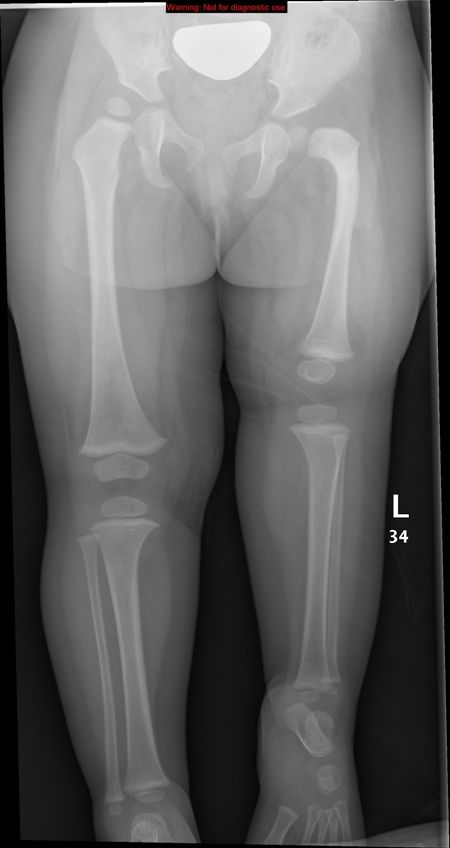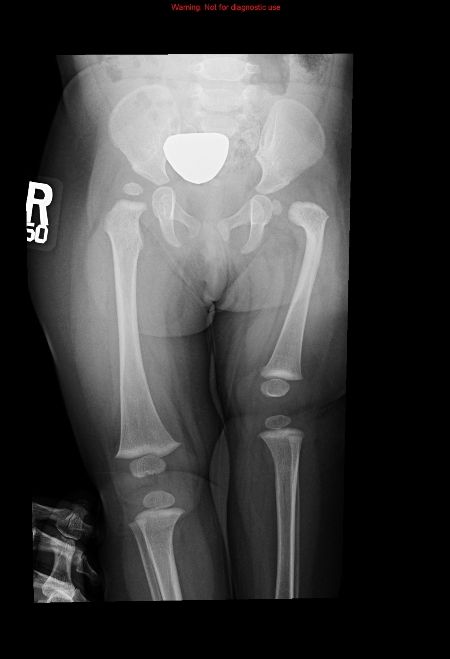Proximal Femoral Focal Deficiency
Newborn baby with short left lower limb with appearance of proximal femoral focal deficiency. Femur is shortened, flexed, abducted, and externally rotated.
Clinical History
New born baby found to have short left lower limb.
Diagnosis
Proximal femoral focal deficiency (PFFD) and left DDH.
Introduction
Proximal femoral focal deficiency (PFFD) is a rare, non-hereditary birth defect that affects the pelvis, particularly the hip bone, and the proximal femur. The disorder may affect one side or both, with the hip being deformed and the leg shortened. In proximal femoral focal deficiency, the proximal femur is partially absent, and the entire limb is overall shortened.
Proximal femoral focal deficiency (PFFD) is an uncommon but complex problem. PFFD was commonly grouped with other disorders, such as coxa vara and short bowed femurs, which led to confusion and misunderstanding. It is commonly linked with the absence or shortening of a leg bone (fibular hemimelia) and the absence of a kneecap, a shortened tibia or fibula, and foot deformities.
Problem
In general, in individuals with proximal femoral focal deficiency, the proximal femur is partially absent, and the entire limb is overall shortened. A few main biomechanical abnormalities are present in children with PFFD, as well as in adults with limb deficiencies. These include limb length discrepancies, malrotation, proximal joint instability, and inadequacy of the proximal musculature.
Epidemiology
Frequency
The incidence of the deficiency ranges from 1 case per 50,000 population to 1 case per 200,000 population.
Etiology
The etiology of proximal femoral focal deficiency is not known exactly, but certain theories have been proposed and agents implicated. Sclerotome subtraction is one such theory that has been offered to explain several different limb deficiencies. Specifically, this theory states that injury to the neural crest cells that form the precursors to the peripheral sensory nerves of L4 and L5 results in PFFD.
A second theory, advanced by Boden et al, states that PFFD may be the result of a defect in proliferation and maturation of chondrocytes in the proximal growth plate. Agents implicated in causing such injuries include anoxia, ischemia, irradiation, bacterial and viral infections and toxins, hormones, mechanical energy, and thermal injury. Thalidomide, when taken by the mother between the fourth and sixth weeks of gestation, has been demonstrated to be a definite cause of PFFD in humans. Currently, no evidence indicates a genetic etiology.




Presentation
The appearance of proximal femoral focal deficiency is not subtle, so it is easily recognized. The femur is shortened, flexed, abducted, and externally rotated. Gillespie noted that, in his patients, the hips were never normal and the knees were dysfunctional. Flexion contractures of the hip and knee are also present. The bulbous proximal thigh quickly tapers to the knee. Because of the short femur and bulbous thigh, examination of the hip can be difficult. As a result of hip instability, pistoning may be present. The knee is uniformly unstable in an anteroposterior plane secondary to absent cruciate ligaments. Additionally, generalized knee hypoplasia has been reported.
A high incidence of fibular deficiency and valgus feet is associated with PFFD. Fibular deficiencies are found in as many as 70 percent to 80 percent of persons with PFFD. Approximately 50 percent of patients with PFFD have other limb anomalies. However, Aitken reported almost a 70 percent incidence of other anomalies. Cleft palate, clubfoot, congenital heart defects, and spinal anomalies, although rare, occur as well. PFFD is bilateral in 15 percent of the cases.
Classification
Several classification systems describe congenital anomalies of the femur, but most have been based on radiographic appearances alone. The Amstutz and Pappas classifications provide detailed radiologic descriptions of the various forms of PFFD that these researchers encountered. Hamanishi described a progressive reduction of the femur, ranging from simple shortening to total absenceFixsen and Lloyd-Roberts divided their patients into stable and unstable categories.
Gillespie and Torode reviewed their patients from both a radiographic and, more importantly, a clinical viewpoint and found that most could be divided into 2 groups. The first group included persons with congenital short femurs, and the second group was composed of individuals with true PFFD. These two groups not only differed with respect to clinical and radiographic appearances but also were functionally unique and had different surgical and prosthetic requirements.
The Aitken classification, which is the most widely used classification, divides PFFD into four categories based on the radiographic appearance. Remember that late ossification may occur, whereby the bone may be present but not visualized radiographically. Occasionally, push-pull comparison radiographs, as well as abduction-adduction views, are necessary to distinguish between class A and class B. Arthrography also can be helpful.
In individuals with Aitken class A, a shortened femur is present proximally, ending at or slightly above the level of the acetabulum. The femoral head is often absent but later ossifies; femoral head presence is indicated by a well-developed acetabulum. Additionally, there is a subtrochanteric defect, which eventually ossifies and thereby establishes bony continuity. After ossification, there is usually a residual subtrochanteric varus deformity.
Persons with class B have a more severe defect or absence of the proximal femur. This defect does not heal spontaneously. At skeletal maturity, there is no connection between the femoral head and proximal femur; the end of the proximal femur is above the acetabulum. The femoral head, although present, may have delayed ossification, and there is often a bony tuft on the proximal end of the shaft.
An individual with Aitken class C has an absent femoral head that does not ossify and a markedly dysplastic acetabulum. The class C femoral shaft is shorter than in a person with class B, in whom the entire proximal femur, including the trochanters, does not develop.
In a person with class D, the most severe form, there is a severely shortened shaft, which often has only an irregularly ossified tuft of bone proximal to the distal femoral epiphysis. No acetabulum is present because the lateral pelvic wall is flat.
In a symposium, Gillespie proposed a more functional classification system in which he divided his patients into 3 treatment groups from a surgical and prosthetic viewpoint. His first patient set, group A, consisted of possible candidates for limb lengthening. This group included individuals who had congenitally short femurs but clinically stable hips, had no significant knee flexion contractures, and had the ipsilateral foot at or below the level of the middle of the contralateral tibia. Gillespie's group B consisted of patients classified by Aitken as classes A, B, and C and who required prosthetic treatment. Therefore, any surgical procedure is designed to maximize prosthetic function. Gillespie's group C represented the same patients as Aitken's class D in that they had subtotal absence of the femur. Gillespie also recommended prosthetic treatment for his group C patients; however, these patients did not require knee fusions prior to prosthetic fitting.
A study of the efficacy of MRI in classifying PFFD also compared MRI findings to radiographic classification. The study, which used the Amstutz classification system, found that radiographic evaluation tends to overestimate the degree of deficiency and that, therefore, MRI is the better modality.
Management
Current management strategies aimed at improving functional ambulation are largely dependent on the degree of femoral shortening and the status of the hip and knee joint. Treatment of acetabular deficiency and proximal femoral deformity in cases of PFFD must be individualized. Reconstruction of the hip joint with pelvic and femoral osteotomies may be possible in mild cases of PFFD. Stability of the hip and knee joint must be achieved prior to consideration for limb lengthening strategies. Severe cases of PFFD may be beyond surgical correction and warrant alternative strategies such as rotationplasty or selective amputation to facilitate prosthetic fitting.
Note: This patient is treated with dynamic screw in left femur.
Dr.Sushila Ladumor, MD, FRCR, Consultant Radiologist with Multi-modality Imaging experience, working in Medical Imaging Department, King Abdulaziz Medical City, Riyadh, Saudi Arabia.
References:
Radiology journal: Proximal Femoral Focal Deficiency
Medscape reference: Proximal Femoral Focal Deficiency
Emerging AI Algorithm Shows Promise for Abbreviated Breast MRI in Multicenter Study
April 25th 2025An artificial intelligence algorithm for dynamic contrast-enhanced breast MRI offered a 93.9 percent AUC for breast cancer detection, and a 92.3 percent sensitivity in BI-RADS 3 cases, according to new research presented at the Society for Breast Imaging (SBI) conference.
The Reading Room Podcast: Current Perspectives on the Updated Appropriate Use Criteria for Brain PET
March 18th 2025In a new podcast, Satoshi Minoshima, M.D., Ph.D., and James Williams, Ph.D., share their insights on the recently updated appropriate use criteria for amyloid PET and tau PET in patients with mild cognitive impairment.
Can Abbreviated Breast MRI Have an Impact in Assessing Post-Neoadjuvant Chemotherapy Response?
April 24th 2025New research presented at the Society for Breast Imaging (SBI) conference suggests that abbreviated MRI is comparable to full MRI in assessing pathologic complete response to neoadjuvant chemotherapy for breast cancer.
Clarius Mobile Health Unveils Anterior Knee Feature for Handheld Ultrasound
April 23rd 2025The T-Mode Anterior Knee feature reportedly offers a combination of automated segmentation and real-time conversion of grayscale ultrasound images into color-coded visuals that bolster understanding for novice ultrasound users.